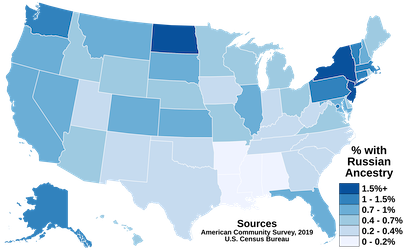
Russian Americans. Americans of full or partial Russian ancestry. The term can apply to recent Russian immigrants to the U.S., as well as to those who settled in the 19th century Russian possessions in northwestern America.
Russian Americans comprise the largest Eastern European and East Slavic population in the U.S., the second-largest Slavic population generally, the nineteenth-largest ancestry group overall, and the eleventh-largest from Europe.
In the mid-19th century, waves of Russian immigrants fleeing religious persecution settled in the U.S., including Russian Jews and Spiritual Christians. From 1880 to 1917, within the wave of European immigration to the U.S. that occurred during that period, many Russians immigrated primarily for economic opportunities.
These groups mainly settled in coastal cities, including Brooklyn (New York City) on the East Coast, and Los Angeles, San Francisco, Portland (Oregon), and various cities in Alaska, on the West Coast, as well as in Great Lakes cities, such as Chicago and Cleveland.
After the Russian Revolution of 1917 and the Russian Civil War of 1917–1922, many White Russian émigrés also arrived, especially in New York, Philadelphia, and New England.
Emigration from Russia subsequently became very restricted during the Soviet era (1917–1991). However, after the dissolution of the Soviet Union at the end of the Cold War, immigration to the U.S. increased considerably.
In several major U.S. cities, many Jewish Americans who trace their heritage back to Russia and other Americans of East Slavic origin, such as Belarusian Americans, sometimes identify as Russian Americans.
Notable Russian Americans: Isaac Asimov, Vlada von Shats